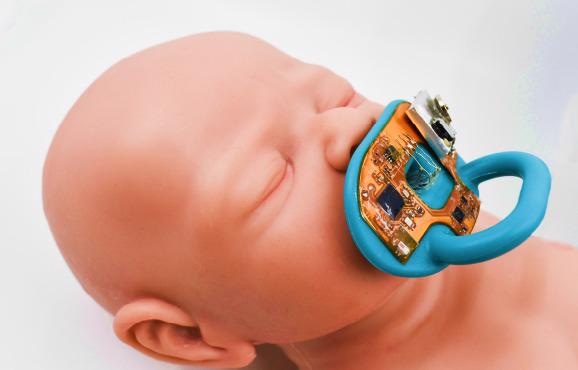The need to carry out invasive, twice-daily blood draws to track the electrolyte levels of babies in the Newborn Intensive Care Units (NICUs) could be eliminated thanks to a wireless, bioelectronic pacifier.
 A wireless, bioelectronic pacifier could eliminate the need for invasive blood draws. Image Credit: Washington State University.
A wireless, bioelectronic pacifier could eliminate the need for invasive blood draws. Image Credit: Washington State University.
This innovative pacifier can also deliver more continuous tracking of potassium and sodium ion levels. These electrolytes help warn caregivers if a baby is dehydrated, a hazard for infants, particularly those born prematurely or with other health problems.
Scientists verified the smart pacifier on a group of infants in a hospital, and the outcomes were comparable to data obtained from their regular blood draws. In a proof-of-concept study that was published in the journal Biosensors and Bioelectronics, the researchers illustrated their findings.
We know that premature babies have a better chance of survival if they get a high quality of care in the first month of birth. Normally, in a hospital environment, they draw blood from the baby twice a day, so they just get two data points. This device is a non-invasive way to provide real-time monitoring of the electrolyte concentration of babies.
Jong-Hoon Kim, Study Co-Corresponding Author and Associate Professor, School of Engineering and Computer Science, Washington State University
The blood-draw technique can be quite painful for the baby, and it leaves huge gaps in data since they are typically performed one time in the morning and one time in the evening, Kim mentioned. Other approaches have been created to test infants’ saliva for these electrolytes, but they involve large, inflexible devices that necessitate a separate sample collection.
Using a pacifier that is prevalent in the market, the team developed a platform that samples the saliva of a baby via microfluidic channels. When the baby has the pacifier in its mouth, saliva is innately attracted to these channels, so the device does not necessitate any sort of pumping system.
The channels contain small sensors inside that quantify the concentrations of potassium and sodium ions in the saliva. Then, this data is then transmitted wirelessly to the caregiver via Bluetooth.
For the subsequent development phase, the researchers plan to make the parts more economical and recyclable. Then, they will aim to organize a larger test of the smart pacifier to confirm its effectiveness.
Kim explained that the development of this device is part of a bigger effort to help make NICU treatment less upsetting for newborn patients.
You often see NICU pictures where babies are hooked up to a bunch of wires to check their health conditions such as their heart rate, the respiratory rate, body temperature, and blood pressure. We want to get rid of those wires.
Jong-Hoon Kim, Study Co-Corresponding Author and Associate Professor, School of Engineering and Computer Science, Washington State University
Besides Kim, the study’s co-authors include scientists from Georgia Institute of Technology, Pukyong National University, and Yonsei University College of Medicine in South Korea as well as WSU.
Journal Reference:
Lim, H-R., et al. (2022) Smart bioelectronic pacifier for real-time continuous monitoring of salivary electrolytes. Biosensors and Bioelectronics. doi.org/10.1016/j.bios.2022.114329.
Source: https://wsu.edu